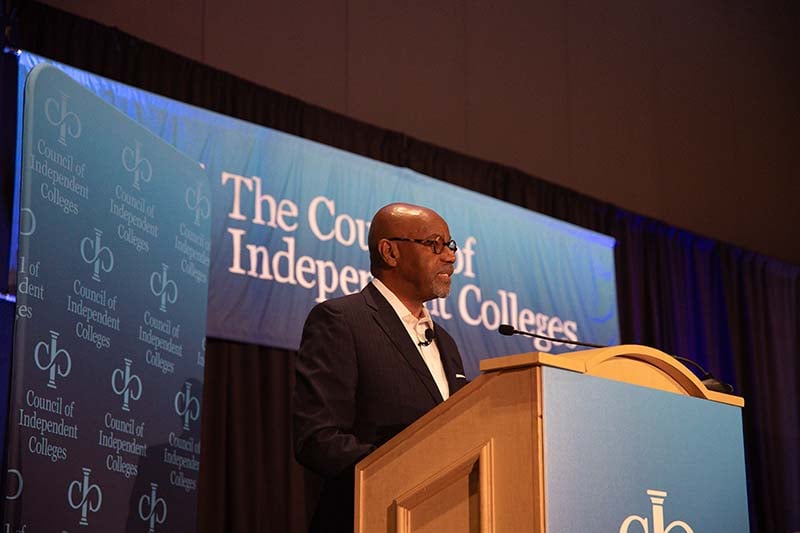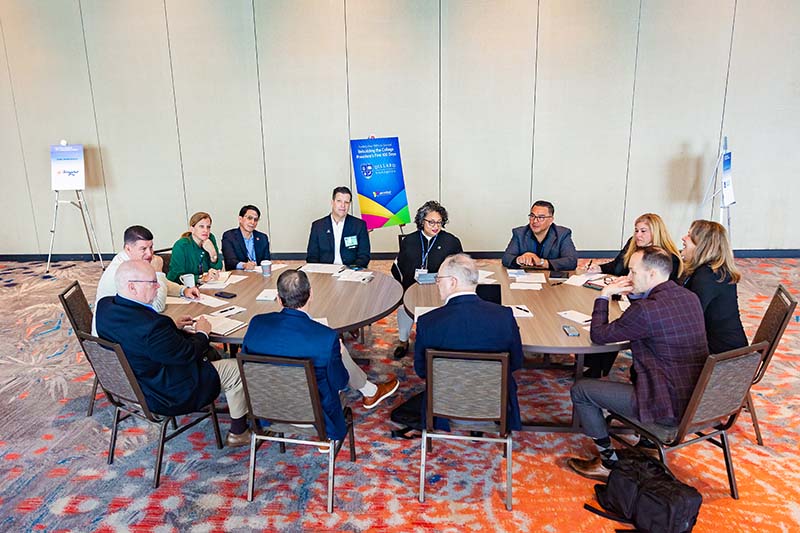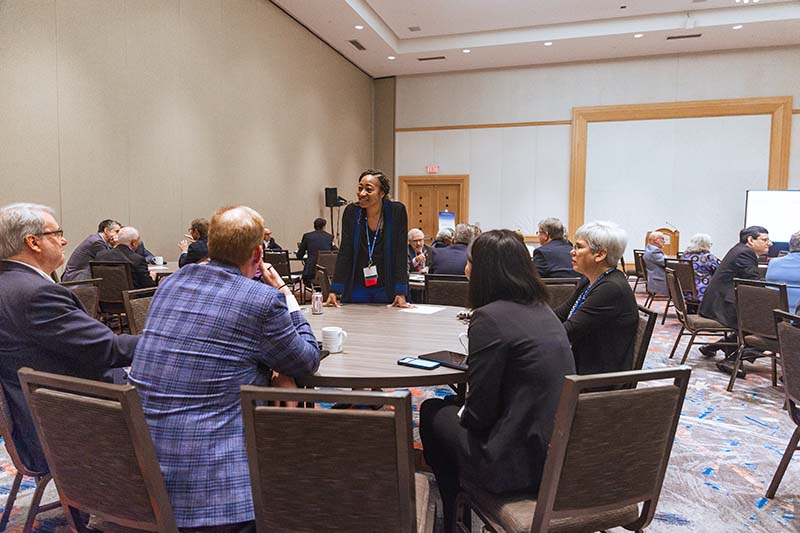CIC member institutions reflect the diversity of the United States. The missions, values, and student and faculty makeup of CIC members varies widely, and CIC strives to acknowledge and respect these differences to support college and university leadership, advance institutional excellence, and enhance public understanding of independent higher education’s contributions to society.
The 2024 Presidents Institute affirmed a shared commitment to the essential role of higher education in fostering civic values at a time and place in which higher education is at the center of intense political debate. The theme, Under the Big Tent: Independent Higher Education in a Democratic Society, engaged that topic through thought-provoking plenary sessions, exciting concurrent and discussion sessions, collaborative workshops, and unstructured time for all participants (presidents, presidential spouses and partners, and industry experts) to engage with and learn from one another.
In addition to the main Program for Presidents, the Institute included a parallel Program for Presidential Spouses and Partners. Prior to the opening of the Presidents Institute, CIC also offered the New Presidents Program (NPP) for CIC member presidents in their first or second year and a parallel Program for Spouses and Partners of New Presidents.
Plenary Sessions
Plenary sessions at the Presidents Institute focused on the state of higher education and the role of leadership and institutions within that space. Topics of the plenary sessions varied widely, but the main conclusion was that no matter how new something feels, history tends to repeat itself. It is essential to look to the past to prepare for the future.
The opening plenary session, “Independent Higher Education in a Democratic Society,” was a panel discussion about the crucial place of CIC member institutions in a functioning democracy. The panel featured Robin E. Baker, president of George Fox University (OR); L. Song Richardson, president of Colorado College; and Stephanie Herseth Sandlin, president of Augustana University (SD); and was moderated by Elfred Anthony Pinkard, president in residence of CIC. Pinkard began the discussion by quoting John Dewey, American philosopher and educator: “Democracy has to be born anew every generation, and education is its midwife.”
Panelists then spoke about how they and their institutions have learned from the past to equip this new generation for the polarization and partisanship on their campuses and the importance of the independent sector in these conversations and preparations. They also outlined specific ways in which they are supporting their students and faculty in taking part in these conversations, such as opportunities to build skills for civic discourse and citizenship, tools for courageous conversations, and even cross-campus dialogues. Panelists encouraged participants to stay focused on programming instead of getting pulled into the political fray or be used as a proxy, but to continue to create deliberate ways of valuing differing opinions and diversity.


The second plenary session, “A New Model for Managing Risk as a College or University President,” featured Juliette Kayyem, Belfer Senior Lecturer in International Security at the Harvard Kennedy School of Government and author of The Devil Never Sleeps: Learning to Live in an Age of Disasters. Kayyem’s presentation outlined steps to manage risk and prepare institutions to “fail safer.” Disasters are recurring and cyclical in nature; it is essential to look to the past to prepare for the future, but Kayyem argued that leaders should focus on crisis management planning rather than prevention. Kayyem introduced the Probability Consequence Risk Framework, stating that institutions should focus on high consequence, high probability events (although she also noted with some levity that the more prepared one seems, the more difficult it will be to justify these efforts, using the example of Y2K.) She suggested reviewing crisis management plans and organizational architecture to prolong the opportunity to respond, or “extend the runway,” and preparing for general impactful events instead of many specific scenarios. Above all, Kayyem recommended that leaders reinforce the values and mission of the institution. College and university presidents do not need to respond immediately to every event, but it helps to provide numbers and data in public communications along with hope and empathy as they continue to highlight what their institutions do best. In doing so, leaders should focus on the audience receiving these messages and what information they would need or want. Immediately following the plenary session, participants applied these risk management principles in interactive case study sessions.


The third plenary session, “Artificial Intelligence and the Responsibility of Higher Education,” featured Jennifer Keating, teaching professor at the University of Pittsburgh (PA), and Illah R. Nourbakhsh, K&L Gates Professor of Ethics and Computational Technologies at Carnegie Mellon University (PA), who spoke about the ways in which technologists both underestimate and overestimate the impact of new technologies and artificial intelligence. Both presenters outlined the benefits of using data generated by AI (for example, in analytics, assessment, and accreditation), but only if there is a strategy and an agile team in place to use the data, and only if the use of AI tools is increasing the agency of the humans using them (not replacing human work and thought). They noted the three blind spots with AI data analysis: exceptional cases and outliers, context, and bias, all of which can have significant negative impacts. They also warned that AI only provides performance or predictability, not both. Keating and Nourbakhsh then offered practical solutions, such as expanding organizational infrastructure and offering consistent opportunities and workshops, both internal and external, for faculty and staff to gather and hear guest speakers or share experiences with AI. They also recommended teaching faculty, staff, and students about the history of the evolution of computational science, and the diverse perspectives of the AI founders and system developers. Finally, they suggested creating a ritual way to evaluate AI usage. Since AI is not a field skill and there are constant changes to the technology, institutions should create a task force to take quick actions and prepare for long-term impact. CIC is exploring solutions—including perhaps its own network—for members related to Artificial Intelligence to support member needs and continue to grow as the field grows.


The closing plenary session, “The Policy Agenda for Independent Higher Education,” featured a discussion between Marjorie Hass, president of CIC, and Barbara K. Mistick, president of the National Association of Independent Colleges and Universities (NAICU). Both organizations play an important role in representing, supporting, and advocating for private, independent colleges and universities. Hass and Mistick spoke about the importance of representing member institutions in the federal government and maintaining relationships with elected officials and representatives. They acknowledged that frustrations from the public about higher education have been brewing for a long time across parties, mainly due to the cost of college. They spoke about challenges with the new Free Application for Federal Student Aid (FAFSA) and the rollout of upcoming changes to Title IX regulations. Hass and Mistick also discussed the impacts to staffing and budgets with the changes to overtime eligibility regulations on campuses proposed by the U.S. Department of Labor, particularly for positions in student life and admissions since they often work outside typical daytime hours to accommodate events and campus tours. They also recognized that the subject of higher education, specifically the cost of college and repayment of student loans, will be a contentious one in the next presidential election year. However, Mistick emphasized that the “American dream” of wanting to attend college is still alive, and that a college education and experience is still part of that dream. The value of a college degree is still important, and student demographic data (i.e., diversity of economics, race, age, etc.) for four-year, private colleges match four-year public institutions, and yield a higher graduation rate. Putting students first and maintaining a unified voice in divisive times is the best path forward.


Concurrent Sessions and Risk Management Case Studies
The Presidents Institute offered many engaging concurrent sessions, including “Nurturing Students from Recruitment to Career Launch,” “Thriving through Community Relationships,” “Balancing Mission and Marketplace,” “Cushion the Fall Off of the Enrollment Cliff,” and “The Future of American Democracy: A Discussion of Hope and Healing.” Currently serving college and university presidents also held confidential exchanges and opportunities for support, including “Lessons from Florida’s Politically Charged Climate,” “‘First’ in Their Role: Pioneering Presidents Breaking Barriers,” and “Navigating Boardroom Politics.”




For the first time, CIC offered Risk Management Case Studies directly following the plenary session, “A New Model for Managing Risk as a College or University President,” for participants to collaboratively apply risk management principles and tools. Topics addressed in the Case Studies included Free Expression, Health Emergency, Campus Violence, and Financial Emergency.








